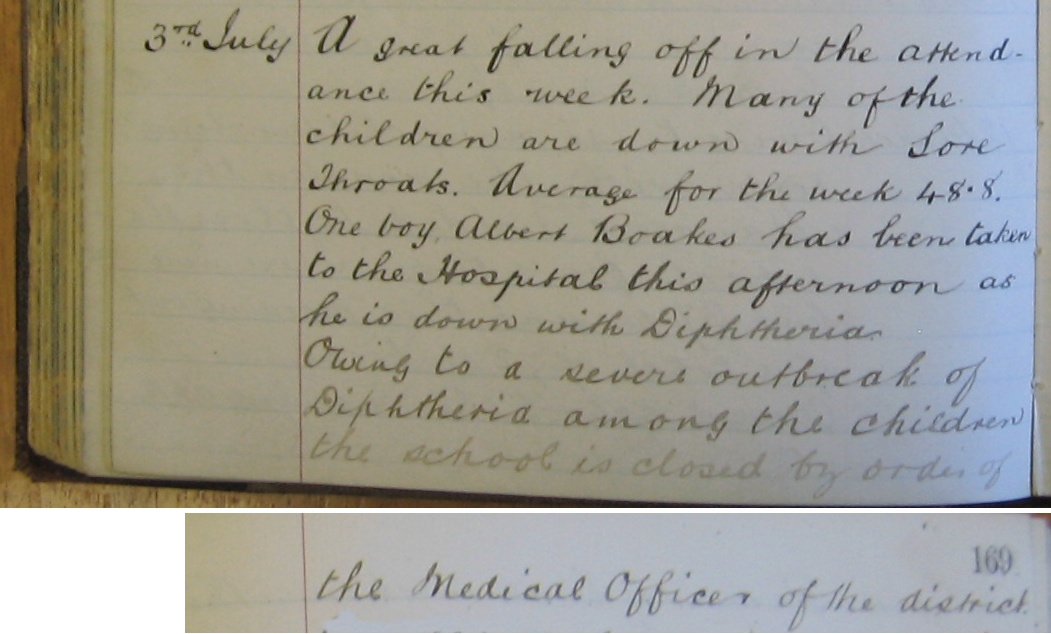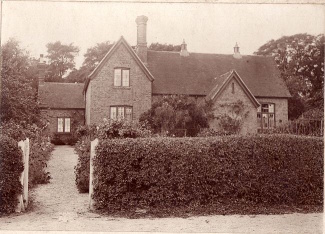
The Diphtheria Outbreak of 1896 .... part 1
School closures as a result of outbreaks of infectious disease are nothing new. The school log for the 3rd of July 1896 shows that the headmaster had to close the school because of an outbreak of diphtheria. The headmaster wrote,

“A great falling off in the attendance this week. Many of the children are down with sore throats. Average (attendance) for the week 48.8. One boy, Albert Boakes, has been taken to the hospital this afternoon as he is down with Diphtheria. The school is closed by order of the Medical Officer of the district.”
Diphtheria is spread by the respiratory droplets of an infected person, such as those produced by a cough or sneeze. It can also be spread by contaminated objects or foods, such as contaminated milk. The mortality rate is around 10% and recovery can be very slow. It killed one of Queen Victoria’s children. Immunisation was introduced into Britain in 1940, reducing childhood deaths from around 8,000 a year in the 1890s to just a handful today.
The outbreak was first discussed at the Rural District Council and this was reported in the local newspaper for the 11th of July 1896.
From the East Kent Gazette 11th July 1896
SERIOUS OUTBREAK OF DIPHTHERIA
The MEDICAL OFFICER reported as follows, under date of July 6th.
Hartlip. - I am sorry to inform the council that a sudden outbreak of diphtheria has appeared in this locality, and to-day I have made an inspection with Mr Grant (the Inspector of Nuisances). The first notification I received was on Sunday the 5th instant, and the same post brought a letter from the Matron of the hospital informing me of the death of the child. Up to this date nine cases (including one at Chesley, Newington, and who attended Hartlip School) have been reported and removed to the isolation hospital. I was informed in more than one quarter that foul smells had been noticed in one particular class-room in the school, and that all, or most of those affected, had studied in this room. Here a water tank exists under the floor, and the smell from the water when drawn being foul and offensive in the extreme.

It may be that sewer gas finds it way through an overflow pipe, in which case the cause of the outbreak is apparent, but, as the builder will take some time in opening this out, this will be reported upon at the next meeting of the council. I understand there is much association in the fruit grounds with the Rainham folks, and probably Gillingham also, and as diphtheria has been frequent in these two places for some time past it may have been communicated in this way. So-called “sore throat” (which is probably diphtheria in a sub-acute form) has been noticeable in this parish for some weeks and attendance at the school could spread the mischief. I have recommended the schools to be closed indefinitely which will probably be until after hopping.
Mr. GRANT said that since this report was written other cases had been taken to the hospital. There were at present twelve cases there, and ten out of the twelve patients came from Hartlip.
Mr GRANT said that the Medical Officer and himself were of the opinion that the outbreak might have started with one case and been communicated to other places. He had heard of several cases of sore throat at Chesley in which no doctor had been called in. He had made arrangements to have the tank under the school thoroughly investigated and cleaned out. It had not been cleansed for sixteen years, not, in fact, since the school was built. The tank was originally in the open, but the class-room was added and built over it. The supply from the tank was the only water supply at the school. It was quite possible that there was an overflow pipe connecting with a drain, which caused the tank to fill with foul gas. The matter was now being investigated, the school having been closed on Friday. All steps that were possible to prevent the spread of the disease had been taken, the patients being removed to the hospital and the houses disinfected.
It is not clear where the tank referred to was. The photo shows the school before the extension of 1907 was added. The left-hand side was the school house where Mr Labrum and his family lived. The school seems to comprise the room that was specified in 1854 “of not less dimensions than nineteen feet high seventeen feet wide and thirty-four feet long”. It is likely, therefore, that the room referred to had been added to the rear.